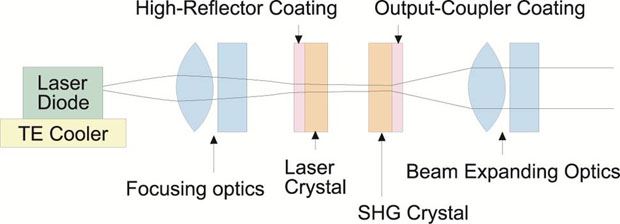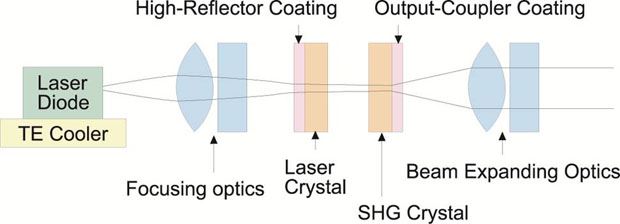DPSS lasers(Diode-pumped solid-state lasers) are solid-state lasers made by pumping a solid gain medium, for example, a neodymium-doped YAG crystal, with a laser diode. DPSS lasers have advantages in compactness and efficiency over other types, and high power DPSS lasers have replaced ion lasers and flashlamp-pumped lasers in many scientific applications.
You can see some DPSS laser modules here at BeamQus.
What are inside the DPSS laser module ?

The typical wavelengths:635 nm, 650 nm,660 nm, 670 nm, 690 nm, 780 nm, 830 nm, 860 nm, 915 nm, 940 nm, 1064nm, 1310 nm, 1480 nm, 808 nm and 532 nm. The most used wavelengths in industrial laser equipment are 1064 nm, 532 nm, and 808 nm.
The most common DPSS laser in use is the 532nm wavelength green laser pointer. A powerful (>200 milliwatt) 808nm wavelength infrared laser diode pumps a neodymium doped yttrium orthovanadate (Nd: YVO4) crystal which produces 1064nm wavelength light. This is then frequency doubled using a nonlinear optical process in a KTP crystal, producing 532nm light. Green DPSS lasers are usually around 20% efficient, although some lasers have been reported to be 35% efficient. In other words, a green DPSS laser using a 2.5W pump diode would be expected to output around 500mW of 532 nm light.
Blue DPSS lasers use an extremely similar process, except that the 808nm light is being converted to 946nm light, which is then frequency-doubled to 473nm. Because of the lower gain for the materials, blue lasers are relatively weak and are only around 3% efficient.
Yellow lasers use an even more complicated process. A 808nm pump is used to generate 1064nm and 1342nm light, which is summed to become 593.5nm. Yellow lasers are about as efficient as blue lasers, but due to their complexity and costs, most yellow DPSS lasers are only around 1% efficient.



